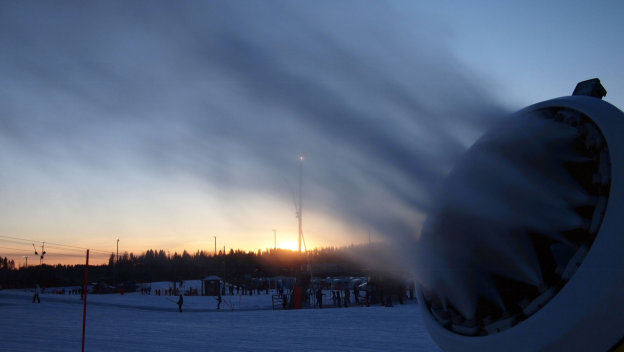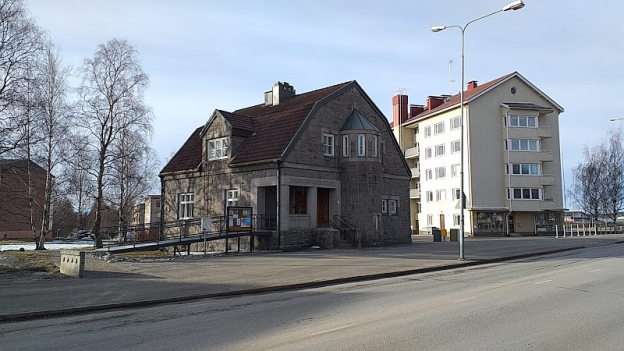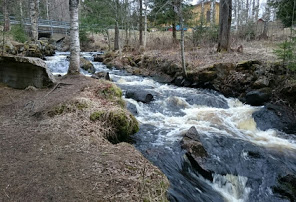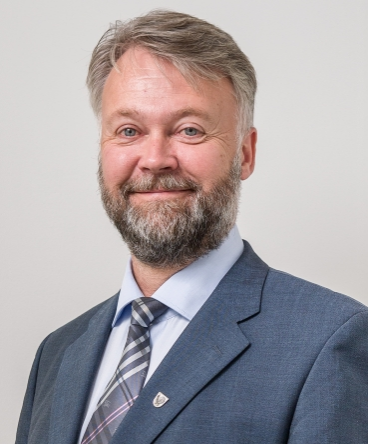Jämsä 作者: 来源: 发布时间:2021-06-21
一、所属省或是州,具体位置,人口,面积
Jämsä is a town and municipality of Finland. It is located in the Central Finlandregion. The municipality has a population of 20,589 (31 January 2019)and covers an area of 1,823.90 square kilometres (704.21 sq mi) of which 252.57 km2 (97.52 sq mi) is water.The population density is 13.1 inhabitants per square kilometre (34/sq mi). The municipality is Finnish. The municipality of Kuorevesi was consolidated with Jämsä in 2001. The municipality of Längelmäki was partly consolidated with Jämsä in 2007. The municipality of Jämsänkoski was consolidated with Jämsä in the beginning of 2009.
It is the center of Finnish aeronautics industry – the aircraft factory and aeronautical engineering offices of Patria is located at Halli Airport in Jämsä. Since 1994, the ski slope at Himos has been used as a super special stage at the Rally Finland.
二、自然地理
1.地理条件
There are all together around 465 lakes in Jämsä. The largest lakes are Päijänne, Koljonselkä and Lake Kuorevesi.Jämsä is located on the west coast of Päijänne in the triangle formed by Tampere, Lahti and Jyväskylä, closer to the fronts of southern Finland than to the northern parts of its province. The population center of Finland, or Weber Point, is located in Hauho, about 80 kilometers southwest of the center of Jämsä. It moves one kilometer a year away from Jämsä to the south. [9] The 62nd latitude runs through Jämsä so that Koskenpää is located north of the latitude. The south-north longitude of Jämsä is roughly 50 kilometers and the west-east latitude is also about 50 kilometers. The focus of the population, ie the center of Jämsä, is quite close to the western shores of Lake Päijänne in the southern part of the municipality.
The nature of Jämsä is a typical forested hilly land dotted with water bodies and openings. Forests are coniferous, birch is also a common tree species. Noble deciduous trees are in Jämsä on the northern edge of their natural range. Lakes and rivers account for about one-seventh of Jämsä's area. In addition to Päijänne, part of Längelmävesi is located in the Jämsä area. Other lakes in the locality include Eväjärvi, IsoRautavesi, Kankarisvesi, Koljonselkä, Kuorevesi, Nytkymenjärvi and Salosvesi, among others.
The height of Jämsä above sea level is quite low, about 80–240 meters. The majority of Jämsä's central city and the surrounding large-scale farming area rises to a maximum height of 120 meters. The lowest areas of the locality include the surface of Lake Päijänne, which rises 78 meters above sea level. Among other things, Kaipolanvuori (233 meters) and the eastern slope of Himosvuori (220 meters) rise. There are large elevation differences in Jämsänniemi in the Himos area, where the Päijänne and Himos slopes are located side by side.
The height of Jämsä above sea level is quite low, about 80–240 meters. The majority of Jämsä's central city and the surrounding large-scale farming area rises to a maximum height of 120 meters. The lowest areas of the locality include the surface of Lake Päijänne, which rises 78 meters above sea level. Among other things, Kaipolanvuori (233 meters) and the eastern slope of Himosvuori (220 meters) rise. There are large elevation differences in Jämsänniemi in the Himos area, where the Päijänne and Himos slopes are located side by side.
2. 交通情况
In Jämsä, Highways 9 and 24 intersect, and the railway connection between Tampere and Jyväskylä runs through Jämsä. The city center Seppola is along the Jämsänjoki River, which flows from Kankarisvesi to Päijänne.
The train and bus stations are located in the city center, about 1.4 km apart. In addition, there are express stops closer to the train station. In the summer, the boat trips between Lahti and Jyväskylä stop in the village of Vaher in Jämsä.
三、经济发展和规模
In Jämsä, tourism has become a significant industry. Himos Ski Resort is located in Jämsä and has expanded from a ski resort to a vibrant year-round tourist center. In the summer, Himos hosts numerous large events, e.g. HimosFestival and IskelmäHimos. Jämsä also hosts the largest paintball game in the Nordic countries "Suurpeli" every year. Finland's largest paintball attracts more than 600 players every August.
The municipality's largest employers are UPM-Kymmene Corporation's two paper mills, the Jokilaakso mills. The distance between Kaipola and Jämsänkoski is about 14 kilometers. In addition to Äänekoski, Jämsä is another well-industrialized municipality in Central Finland.
四、产业特点重点项目
It is the center of Finnish aeronautics industry – the aircraft factory and aeronautical engineering offices of Patria is located at Halli Airport in Jämsä.
JämsänkoskiOy was founded in 1887 to engage in the forest industry. JämsänkoskiOy consisted of a sulphite pulp and paper mill and a sawmill. In 1920, the mill became part of the United Paper Mills, to which JämsänkoskiOy was merged. At the same time, Jämsänkoski had developed into its own community and gained the status of a merchant in 1926. Jämsänkoski also served for a short time as the headquarters of United Paper Mills in the 1940s under General Juuso Walden TheJämsänkoski mill is larger than the Kaipola mill, which has four operating paper machines. The factory has an annual capacity of 880,000 tons. The Jämsänkoski mill produces uncoated magazine paper and label and packaging paper. In 2002, a biopower plant was established in Jämsänkoski.
United Paper Mills Kaipola established a paper mill at the mouth of the Jämsänjoki River, as the company had to make up for the loss of the Myllykoski mill with a new mill. 1952 The paper mill established in the village of Kaipola now produces LWC, newsprint and catalog paper. Before HelsinginSanomat, it was also printed on Kaipola paper. The Kaipola paper mill has three operating paper machines with an annual production of more than 700,000 tons. Kaipolaalso has Finland's largest deinking plant and its own steam power plant. In the 1950s, Kaipola developed into a small community of its own thanks to the factory.
In addition to the paper industry, Jämsä also has an aircraft industry, which is operated by Patria Kuorevesi Hall, where the Air Force Technical School has also operated. Jämsä is the only municipality in Finland that still has an aircraft industry.
Felting began to come from Russia to Finland in the late 19th century, and the skill was also adopted in Jämsä. A considerable concentration of the felt industry was created in the Jämsä region, and the village of Partala had at its best up to ten small felt factories. The making of felt slippers was also adopted in Koskenpää at an early stage. Founded in 1921, Alex Lahtinen's carding and felt shoe store is today the oldest felt shoe factory in Finland. [78] In the 1990s, the blanket became a fashion material for making ornaments, clothing and accessories, hats and jewelry. The School of Arts and Crafts, founded in Petäjävesi, also offers training in the field of felt.
五、风景名胜,景点( attractions)
1. Himos Ski Resort

Himos Holiday Resort is located in southern Province of Central Finland, in a cozy city of Jämsä.
The landscape in the area is characterized by forest, rolling hills, lush fields and endless amount of lakes.
Himos is international, all-year-around active resort, offering its customers positive surprises and fresh physical and emotional experiences.
2. Gallery Stone Bank

One of the famous museum in Jämsä. During different period of the year, Gallery Stone Bank has been changing exhibitions and are events.
3. Nytkymenjoki

Juveninkoski is an almost vertical waterfall in the village of Partala, in the town of Jämsä. It gets its water from the small Nytkymenjokiriver in the area. The fall is located east of the Partalantie road, right after the road crosses the river. The water plunges down a Rocky Cliff for almost 7 meters, but the total drop height of the rapid is even more than that. After the fall, the flow of the river slows down.
Juveninkoski is reportedly the highest and steepest free-flowing waterfall in Central Finland, which is why it is one of the most famous nature sights in Jämsä today. Especially during the spring floods in April and May, the fall is a gorgeous sight with the water rushing down the Cliff, forming great white water. Later in the summer, too, the rapid is a pleasant attraction as one can see the rapid in the green embrace of the surrounding trees and bushes.
It is easy to get to admire and photograph Juveninkoski, for the walking distance from the Partalantie road to the edge of the fall is only about twenty meters. You can leave your car at the side of the road or on a small parking area near the fall. It is also easy to get to see the waterfall from below, by descending the hill on the north side of the river. It is worth noting that the mist caused by the fall may cause problems when taking photos of it too close up.
4. Jämsänmuseo, Pälämäenkotiseutumuseo

It was decided to establish an open-air museum in Jämsä in 1947. At the end of the same year, a hometown association was established. In addition to Jämsä, this old Jämsä hometown association included Jämsänkoski and Koskenpää.
In 1949, Jämsänkoski and Koskenpää resigned from the Homeland Association and at the same time the name was changed to the Jämsä Homeland Association. Pälämäki, located on a hill between the Jämsänjoki and Vaher roads, was chosen as the museum's location. The land is for rent from the People's College.
The museum was inaugurated in 1950 and belonged to the Homeland Association. The museum moved to the city in 1972. When the Folk High School was built in 1915, a wealth of iron antiquities were found in the area. According to research, Pälämäki has been one of Jämsä's cremation graves. The oldest objects found in the area are dated to 950-1050.
六、历史文化
1.历史
In the current Jämsä region, the ice age ended ten thousand years before the beginning of time. At that time, the edge of the ice retreated for about a mile in eight years. The ice age left behind transition valleys, gravel ridges and clayey. Päijänne was initially a bay; it formed an independent body of water about 6,000 years BC. Ancient Päijänne extended from the present-day Pihtiputa region to Salpausselä and its surface was ten meters higher than at present. Around the year 4000 BC. Ancient Päijänne broke down a runway south of the present-day Kymijoki River and its surface rapidly declined. Over the following millennia, the surface of Päijänne gradually fell to its current level. The lowering of the water level led to the formation of several small water bodies. Some old place names refer to a higher waterline, such as Saari in the middle of a field. Stone Age settlements have been found in the Jämsä region, such as Hietamäki north of the Patajoki River, where the oldest finds date back to around 7550 BC.
Half a dozen Iron Age settlements have been found in the Jämsä area. Based on the grave finds from Puttola, it has been concluded that Jämsä got its first inhabitants in the 9th century, when the Viking Age was lived. It was at this time that the period of uninterrupted settlement leading to modern times began. The oldest traces of settlement are of Häme origin. At the end of the Iron Age, Jämsä was the northernmost concentration of permanent settlement in Häme, Päijänne. Numerous memories of the ancient Lappish settlement have remained in the nomenclature of the locality. Jämsä was the hinterland of Häme and according to legend, people from Sahalahti and Sääksmäki moved to the area. Many parishes in southern Häme have villages of the same name as in Jämsä. There are two Iron Age ancient castles in Jämsä: Pukinvuori and Linnasenvuori.
2. 文化
Jämsä's building culture has distinctive features. Many of Jämsä's farms prospered into large houses in the 19th century, and they competed for wealth with each other. The main building of the house was designed to be built or decorated in accordance with the style flow of the time. Thus, many of the big houses still represent so-called repetition styles today. Neoclassicism is represented by Ruotsula and Kuikka, and a few houses in Juokslahti, Patajoki and Koskenpää have materials of the same style. Neo-Gothic can be seen in the houses of Kaipola and Karhala. The Neo-Renaissance is only represented in the Nikkar-style Vitikkala House. The Neo-Baroque, on the other hand, has left its mark on Saari Manor. The making of mansard roofs originated in the Baroque. Such was also done retrospectively for several houses that otherwise represented a different style. Such are, for example, the houses of Heinäkengä and Palmroth. All of the attic roofs were probably made by one and the same master builder whose name is unknown. It is a specialty of Jämsä that attic roofs can be seen combined with other style houses.
七、其他信息
The most famous of Jämsä's many gorges is probably the Sin Lock, which is located northwest of the center of Jämsä. There are numerous legends associated with the lock of sin. The Vororot gorge complex is located southwest of the center of Jämsä. Significant gorges are also Mullikkarotti, Pirunryöni, Rotkojärvi or Ruuhijärvi and Surmajärvi Sin Sinlukko.
八、联系方式

Mayor of Jämsän town: TapaniMattila
Website: https://www.jamsa.fi/
Phone number:020 638 2000
Email:etunimi.sukunimi@jamsa.fi
Address: Keskuskatu 17, 42100 Jämsä
